The Ultimate Homemade Tomato Soup from Canned Tomatoes: A Quick, Healthy, and Flavorful Pantry Staple
Tomato soup is a beloved culinary classic, cherished for its comforting warmth and vibrant flavor. However, navigating the supermarket aisles for a ready-made version often means confronting a list of unhealthy ingredients that many prefer to avoid. If you frequently reach for canned or boxed soups for their convenience, it’s time to discover the incredible difference of this incredibly easy homemade tomato soup using canned tomatoes. Not only is it significantly healthier, free from excessive sodium, high-fructose corn syrup, and undesirable preservatives, but it also offers the practical benefit of being freezable, making meal prep a breeze for future busy days. The beauty of this recipe lies in its simplicity; you likely already have all the necessary ingredients stashed away in your pantry right now, ready to be transformed into a deeply satisfying and wholesome bowl of soup in just about 30 minutes. Embrace the rich taste and superior nutrition of homemade, and say goodbye to store-bought compromises.
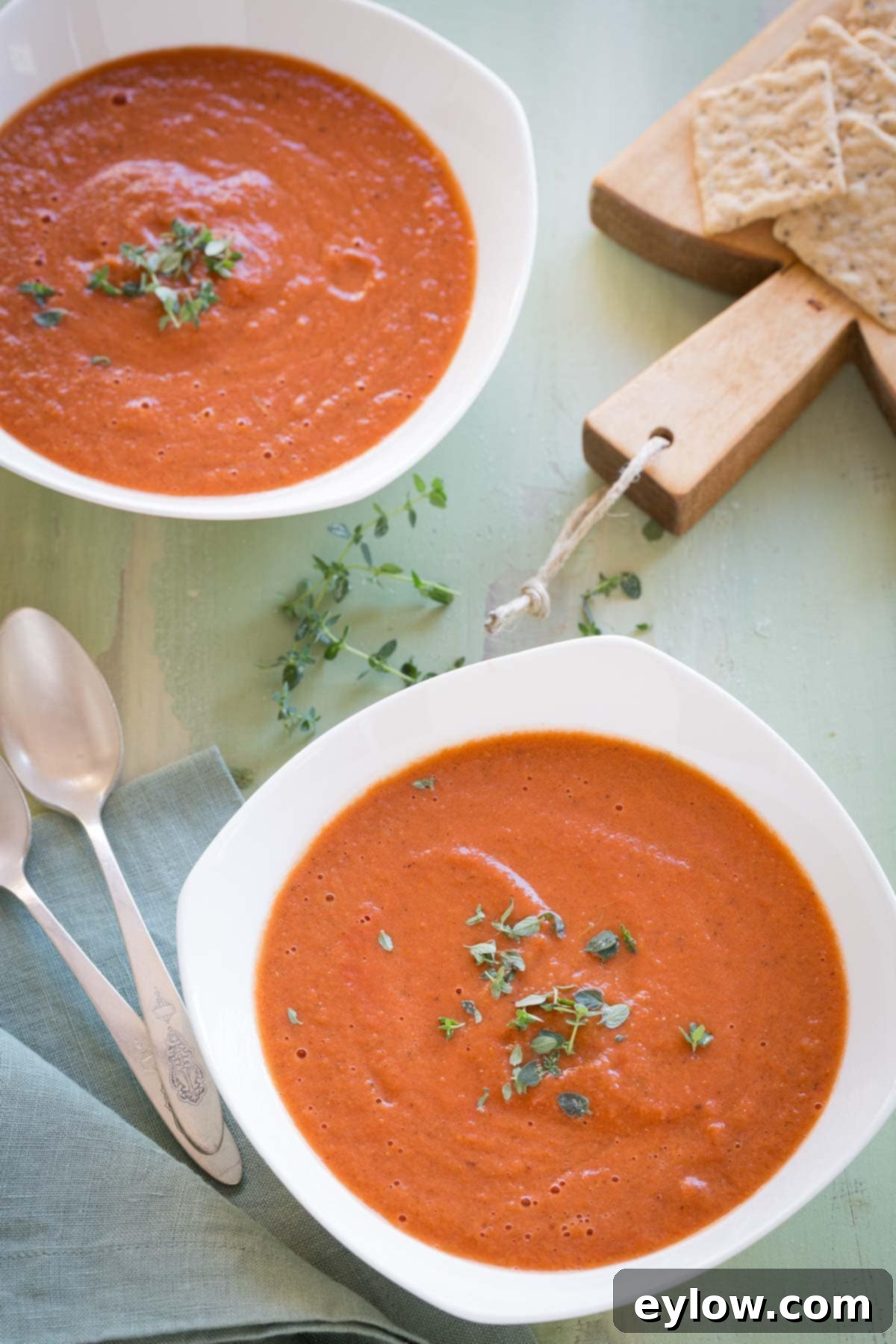
Crafting homemade tomato soup from canned tomatoes is a testament to culinary simplicity and health-conscious cooking. This recipe is designed to be effortlessly straightforward, utilizing ingredients that are staples in most kitchens. Whether you prefer your soup velvety smooth or wonderfully chunky, this recipe adapts to your preference. The stark reality is that many commercially available canned tomato soups are laden with problematic additives. Common culprits include high fructose corn syrup for sweetness, alarmingly high levels of sodium, and artificial preservatives that undermine the nutritional value. Furthermore, some store brands incorporate wheat flour as a thickener, which can be a significant concern for individuals following gluten-free, grain-free, or paleo diets. By choosing to make this homemade version, you gain complete control over what goes into your meal, ensuring it aligns with your dietary needs and health goals. This recipe truly delivers that “mmm mmm good” feeling, promising a deeply flavorful experience that far surpasses any store-bought alternative.
Why You’ll Love This Easy Tomato Soup Recipe
This homemade tomato soup is more than just a meal; it’s a game-changer for your kitchen. Here’s why it’s destined to become a staple in your recipe rotation:
- Effortlessly Easy and Quick to Make: Forget complicated steps or lengthy cooking times. This recipe is designed for maximum flavor with minimal effort, coming together in approximately 30 minutes. It’s perfect for weeknight dinners or when you need a comforting meal in a hurry.
- Ideal for Freezing for Future Meals: Life gets busy, and having healthy, ready-to-eat meals on hand is invaluable. This tomato soup freezes beautifully, making it an excellent candidate for meal prepping. Simply thaw, reheat, and enjoy a wholesome meal whenever time is short.
- Made with Simple Pantry Staples: No need for a special trip to the grocery store. The ingredients list features common items you likely already have, such as canned tomatoes, onion, garlic, broth, and a few dried herbs and spices. This accessibility makes it a reliable option any day of the week.
- Significantly Healthier Than Canned Varieties: By making your own, you completely avoid the high fructose corn syrup, excessive sodium, and unwanted preservatives found in many store-bought tomato soups. You control the quality of ingredients, allowing you to create a nutritious meal that supports your well-being.
- Versatile and Customizable: This recipe serves as a fantastic base for various dietary needs and flavor preferences. Easily adjust seasonings, add cream for richness, or keep it dairy-free and chunky. It adapts perfectly to your taste.
For another simple, vibrant, and creamy soup experience, be sure to explore this bright golden yellow butternut curry soup.
Essential Recipe Ingredients for Your Homemade Tomato Soup
The beauty of this simple tomato soup lies in its straightforward ingredients, most of which are likely already in your pantry. Here’s a detailed look at what you’ll need and why each component is important:
- Canned Tomatoes: These are the star of our show, providing the rich, tangy base for the soup. While I often use canned diced tomatoes for convenience and texture, whole tomatoes or crushed tomatoes work equally well, so feel free to use whatever you have on hand. If using whole tomatoes, a quick squeeze to remove some seeds and a rough chop will suffice. For an extra layer of complexity and a subtle smoky depth, consider opting for fire-roasted canned tomatoes. They elevate the flavor profile without adding extra steps.
- Oil: The foundation of our flavor development begins with a healthy cooking oil. Excellent choices include olive oil, known for its fruity notes, or avocado oil, which offers a neutral flavor and high smoke point. If you prefer, a healthy neutral oil like those from Zero Acre can also be used. It’s crucial to steer clear of conventional vegetable oils, which are often highly processed and less healthy; in fact, it’s a good practice to simply remove them from your kitchen. Alternatively, for a richer, more decadent flavor, unsalted butter is a wonderful option – choosing unsalted allows you to precisely control the overall salt content of your soup.
- Onion: Onions are the aromatic backbone of this soup, contributing a foundational sweetness and savory depth as they sauté. Any common variety will do: a white onion offers a sharp, clean flavor; a yellow or brown onion provides a balanced sweetness when cooked; and a sweet onion will impart a milder, more caramelized note. Finely chopped onion ensures it softens beautifully and integrates seamlessly into the soup.
- Garlic: Fresh garlic cloves are highly recommended for their pungent, aromatic kick that truly elevates the soup’s flavor. Aim for 3-4 large cloves, finely chopped or minced. While fresh is best, if you’re in a pinch, a good quality garlic puree from a tube can be a convenient substitute, though it might lack the vibrant freshness of newly crushed cloves.
- Broth: The liquid base significantly impacts the final taste and body of your soup. I personally prefer homemade chicken broth for its rich, nuanced flavor and controlled sodium content. However, turkey broth or vegetable broth are equally viable options. If homemade isn’t feasible, always opt for low-sodium commercial brands and meticulously read labels to avoid poor-quality additives, artificial flavors, and excessive sodium. Often, you can find higher-quality, preservative-free broths in the freezer section of health food stores or specialty supermarkets. For those looking to make a faster homemade chicken broth, your Instant Pot can create a flavorful batch in a fraction of the time.
- Herbs: Dried herbs are perfectly suitable for this recipe, adding classic Mediterranean warmth. You’ll need dried thyme, oregano, or a pre-mixed Italian blend. These herbs infuse the soup with a savory, earthy aroma that complements the tomatoes beautifully. Feel free to adjust the amounts to suit your personal preference.
- Spices: Ground cumin and smoked paprika are optional but highly recommended additions that bring unique layers of flavor. Ground cumin adds a warm, earthy, slightly nutty note, while smoked paprika provides a delightful depth and a subtle smoky aroma that pairs exceptionally well with tomatoes. If smoked paprika isn’t available, regular sweet paprika can be used for color and mild flavor, but you’ll miss the smoky dimension.
Please refer to the detailed recipe card below for precise measurements of all ingredients, including salt and pepper, which should be adjusted to your taste.
Chef’s tip on vegetable broth: When it comes to vegetable broth, only homemade will truly deliver a superior flavor profile. Many canned and boxed commercial vegetable broths often taste bland, metallic, or overly seasoned, failing to capture the fresh essence of vegetables. Making homemade vegetable broth is surprisingly easy and relatively quick. Using an Instant Pot, you can achieve a rich, flavorful broth in mere minutes of active cooking, followed by a quick pressure release. Without an Instant Pot, simply simmer your vegetable scraps and aromatics for about an hour, then strain, allow to cool, and freeze for future use. The difference in taste and quality is profoundly worth the minimal effort.
Exciting Substitutions and Creative Variations for Your Tomato Soup
One of the best aspects of this homemade tomato soup recipe is its adaptability. Feel free to experiment with these ideas to tailor the soup to your preferences and available ingredients:
- Embrace a Chunky Tomato Soup: If you appreciate a heartier texture, simply skip the puréeing step entirely. The diced tomatoes will retain their shape, creating a delightful rustic soup that offers more substance with every spoonful. This is particularly good if you enjoy a more stew-like consistency.
- Create a Cream of Tomato Soup: For that classic, velvety-smooth cream of tomato soup experience, gently stir in a little heavy cream or half-and-half at the very end of the cooking process, after puréeing. Add it gradually until you reach your desired level of creaminess, being careful not to boil after adding dairy to prevent curdling.
- Add a Spicy Kick: If you crave a touch of heat, introduce a little ground chipotle pepper. Chipotle peppers are dried and smoked jalapeños, offering a smoky heat that complements tomatoes beautifully. Alternatively, a pinch of cayenne pepper will provide a straightforward spicy warmth. Start with a small amount and add more to taste.
- Dairy-Free Creamy Tomato Soup (Tomato Bisque): For a luxurious, dairy-free creamy texture, incorporate a little full-fat canned coconut milk at the end. Its subtle sweetness and rich consistency transform the soup into a fantastic tomato bisque, adding an exotic touch without any dairy. The coconut flavor is typically mild and enhances the tomato without overpowering it.
- Boost with Roasted Vegetables: Before sautéing the aromatics, roast some chopped carrots, bell peppers, or zucchini until tender and slightly caramelized. Add them along with the canned tomatoes for an extra layer of sweetness and vegetable goodness.
- Herbal Freshness: While dried herbs work wonderfully, fresh herbs like basil, oregano, or rosemary can be added at the end for a brighter, more vibrant flavor. Stir in a handful of fresh chopped basil just before serving.
If you own an Instant Pot or another pressure cooker, you might also enjoy this Lentil Soup recipe. It’s a hearty, protein-packed plant-based option that also freezes exceptionally well.
Step-by-Step Guide: How to Make Tomato Soup From Canned Tomatoes
Crafting this delicious homemade tomato soup is a simple and rewarding process. Follow these easy steps to create a comforting meal:
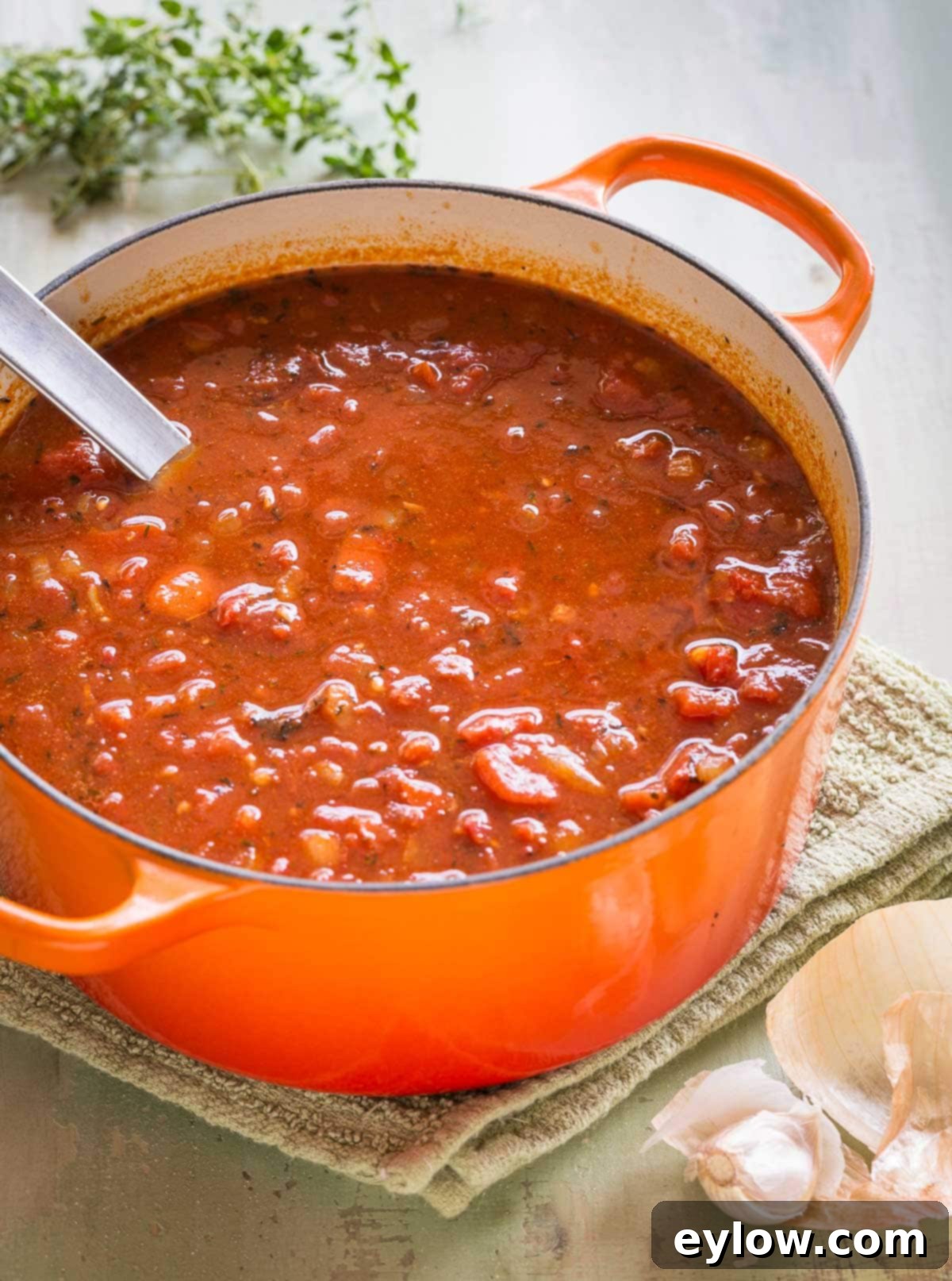
- Step 1: Sauté Aromatics. In a large, heavy-bottomed pot or Dutch oven, heat your chosen oil (olive, avocado, or unsalted butter) over medium-low heat. Add the finely chopped onion and sauté, stirring occasionally, until it becomes translucent and softened, but not browned. This usually takes about 4-5 minutes. Softening the onions slowly allows their natural sweetness to develop, forming a crucial flavor base. Next, add the minced garlic and cook for just 1 minute longer, stirring constantly to prevent it from burning, which can make it bitter.
- Step 2: Bloom the Herbs and Spices. Add your dried herbs (thyme, oregano, or Italian blend) and optional spices (ground cumin, smoked paprika) to the pot. Cook, stirring constantly for 1-2 minutes. This step, known as “blooming” spices, lightly toasts them in the hot oil, releasing their essential oils and intensifying their aromatic flavors before the liquid is added.
- Step 3: Simmer and Blend Flavors. Pour in the broth and the canned tomatoes along with their juices. Stir everything together. Increase the heat to medium-high and bring the mixture to a gentle simmer. Once simmering, reduce the heat to low, cover the pot, and let it cook for 20-25 minutes. This low and slow simmer is essential for the flavors to meld beautifully and for the tomatoes to break down further, creating a more cohesive and deeply flavored soup. Allow the soup to cool briefly before proceeding to the next step.
- Step 4: Purée to Desired Consistency. For a luxuriously smooth soup, carefully purée it in batches using a standard blender. Alternatively, for less fuss and mess, use an immersion blender directly in the pot until you achieve your desired consistency. If you prefer a rustic, chunky texture, you can skip this step entirely.
Once puréed (if desired), rinse the pot to clean it, then return the soup to the pot to gently reheat if needed. Serve warm, garnished as desired with fresh herbs, a drizzle of olive oil, or a swirl of cream. Enjoy your wholesome, homemade creation!
For another easy, reader-favorite creamy soup that’s rich and satisfying, try our black bean pumpkin soup.
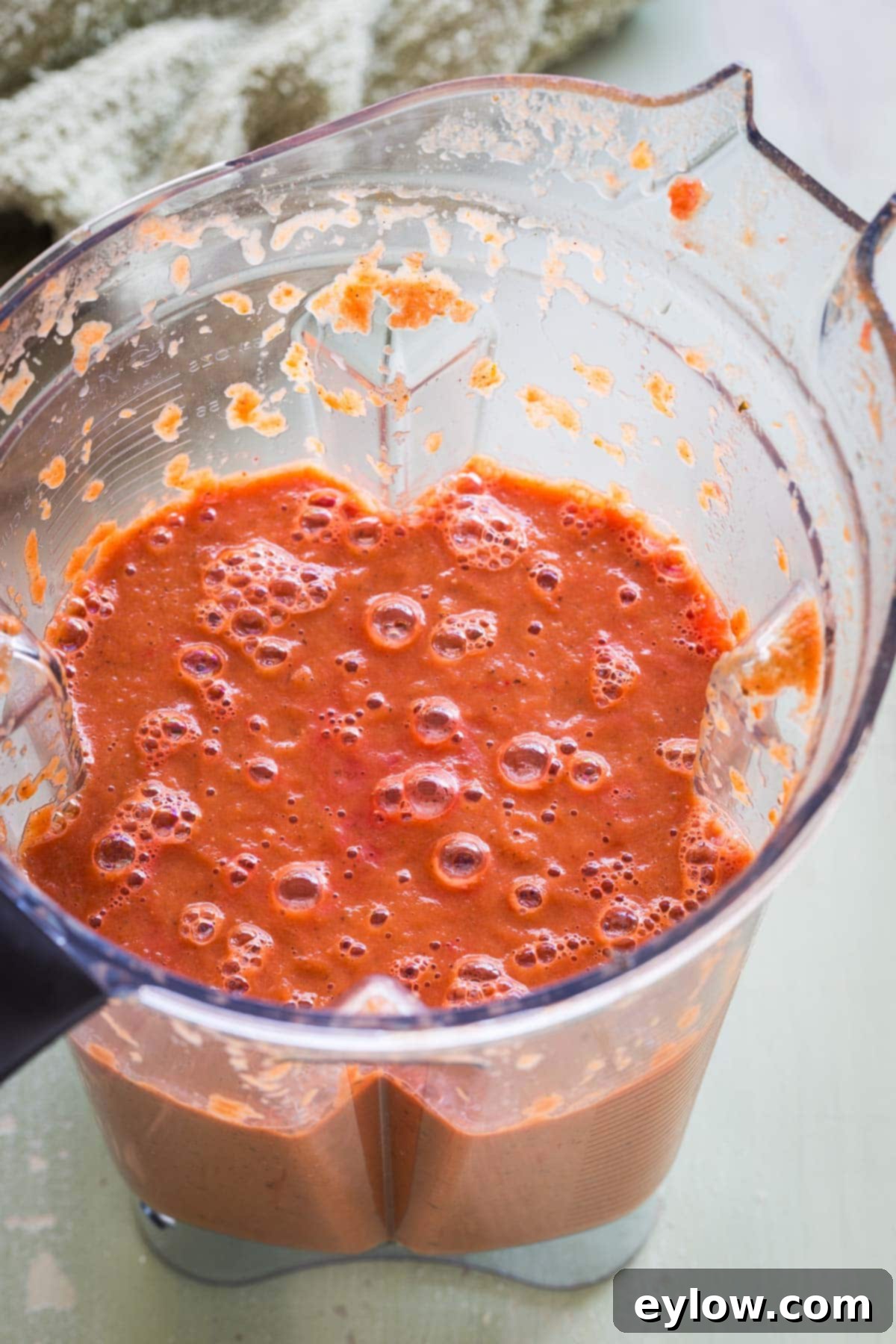
Important Safety Tips for Pureeing Hot Soup
Pureeing hot liquids can be hazardous if not done carefully. Following these safety tips will help prevent accidents and ensure a smooth process:
- Using a Standard Blender: Traditional blenders generally offer the most efficient and smooth puréeing results. However, when working with hot soup, extreme caution is necessary.
- Do Not Overfill: The primary rule is to fill the blender container no more than halfway full. Hot liquids expand and create steam, which can cause the lid to blow off if the container is too full.
- Blend in Batches: Split the soup into two or more smaller batches to avoid overfilling the blender and to manage the heat and pressure safely. Do not attempt to purée all the soup at once.
- Secure the Lid with a Towel: Place a folded kitchen towel firmly over the top of the blender lid. This acts as an extra safety measure to contain any potential splatters and helps hold the lid down against the pressure.
- Start on Low Speed, Then Increase: Begin blending on the lowest speed setting to slowly incorporate the hot liquid and release steam gradually. Once the initial blending is underway and the pressure has equalized, you can gradually increase to a higher speed for a smoother consistency.
- Ventilation: If your blender lid has a removable center cap, remove it to allow steam to escape while blending, but ensure the opening is covered with the kitchen towel.
- Using an Immersion Blender (Stick Blender): An immersion blender offers a convenient, less messy alternative, as it allows you to blend the soup directly in the pot.
- Contain Splatters: To significantly reduce splattering, it’s a good practice to place the pot in the kitchen sink while blending. Wearing an apron is also advisable to protect your clothing.
- Keep the Head Submerged: Ensure the head of the immersion blender is fully submerged in the liquid before turning it on and while blending. This prevents air pockets and minimizes splatters.
- Tilt and Move Gently: Tilt the pot slightly and move the blender gently through the soup to ensure even blending without creating excessive air bubbles or splashing.
- Consider a Chunky Soup: If you are uncomfortable with pureeing hot soup or simply prefer a different texture, remember that you can always serve the soup chunky. This completely bypasses the blending step and results in a rustic, satisfying meal.
Delightful Serving Suggestions for Your Homemade Tomato Soup
A bowl of homemade tomato soup is a comforting meal in itself, but it truly shines when paired thoughtfully. I simply couldn’t conclude this discussion without mentioning the absolute classic pairing: tomato soup and grilled cheese. It’s a nostalgic combination that evokes childhood memories, much like how my mom always served it – simply perfection! The rich, melty cheese sandwich is the ideal counterpoint to the warm, tangy soup.
Beyond this timeless duo, there are many wonderful ways to enjoy your tomato soup:
- With Sandwiches: Serve alongside any of your favorite sandwiches, from a simple turkey and provolone to a hearty Reuben.
- Garlic Toast or Crostini: A slice of crusty garlic toast or crispy crostini is fantastic for dipping and adding texture.
- Artisan Crackers: Elevate your meal with a selection of artisan crackers, providing a delicate crunch.
- As a Starter: This elegant soup makes an excellent starter course for a larger meal, whetting appetites without being too heavy.
- Salad Companion: A light, fresh green salad with a vinaigrette dressing offers a refreshing contrast to the warm soup.
To further enhance your soup, consider these delightful garnishes:
- A Drizzle of Olive Oil: A swirl of high-quality extra virgin olive oil just before serving adds a luxurious sheen and a fresh, peppery note.
- Fresh Herbs: A sprinkle of freshly chopped Italian parsley or basil leaves brightens the flavor and adds a pop of color. Chives or finely sliced scallions also work well.
- Balsamic Syrup: A small drizzle of balsamic syrup (also known as balsamic glaze or reduction) adds a sophisticated sweet-tart accent that beautifully complements the tomatoes. You can find a homemade balsamic syrup recipe here.
- Cheese: A dusting of freshly grated Parmesan cheese or a dollop of soft goat cheese can add a lovely savory or tangy creaminess.
- Dairy Swirls: For a creamy finish, a swirl of sour cream, Greek yogurt, or even a dairy-free alternative like coconut cream can be added.
- Croutons: Crispy garlic croutons add a satisfying crunch and can be homemade for superior flavor.
Freezing Homemade Tomato Soup for Future Enjoyment
One of the most practical advantages of making this easy tomato soup from canned tomatoes is how wonderfully it freezes. This makes it an ideal candidate for batch cooking, allowing you to prepare larger quantities and store them for those demanding days when you simply don’t have time to cook from scratch.
Proper freezing ensures the soup maintains its quality and flavor:
- Cool Completely: After cooking, it is crucial to allow the tomato soup to cool down completely before freezing. Freezing hot soup can lower the temperature of your freezer and potentially affect other frozen foods.
- Speed Up Cooling with an Ice Bath: To accelerate the cooling process safely and efficiently, consider giving the pot an ice bath. Fill your kitchen sink partially with cold water and add a generous amount of ice. Place a trivet or a heat-resistant stand at the bottom of the sink to elevate the pot slightly, ensuring water circulates around it. Stir the soup occasionally to help it cool evenly and quickly, aiming for a temperature below 70°F (21°C).
- Portion and Store: Once thoroughly cooled, ladle the soup into airtight containers. Label each container with the date of freezing. You can use glass jars (leaving headspace for expansion) or these convenient portioned silicone cubes, which are fantastic for freezing individual servings.
- Freezing Duration: Properly stored, your homemade tomato soup will maintain its best quality in the freezer for up to 3 months. While it will remain safe to eat beyond this period, its flavor and texture might begin to diminish.
- Thawing and Reheating: When ready to enjoy, simply transfer the frozen soup to the refrigerator to thaw overnight, or gently reheat from frozen in a saucepan over low heat, stirring occasionally until warmed through.
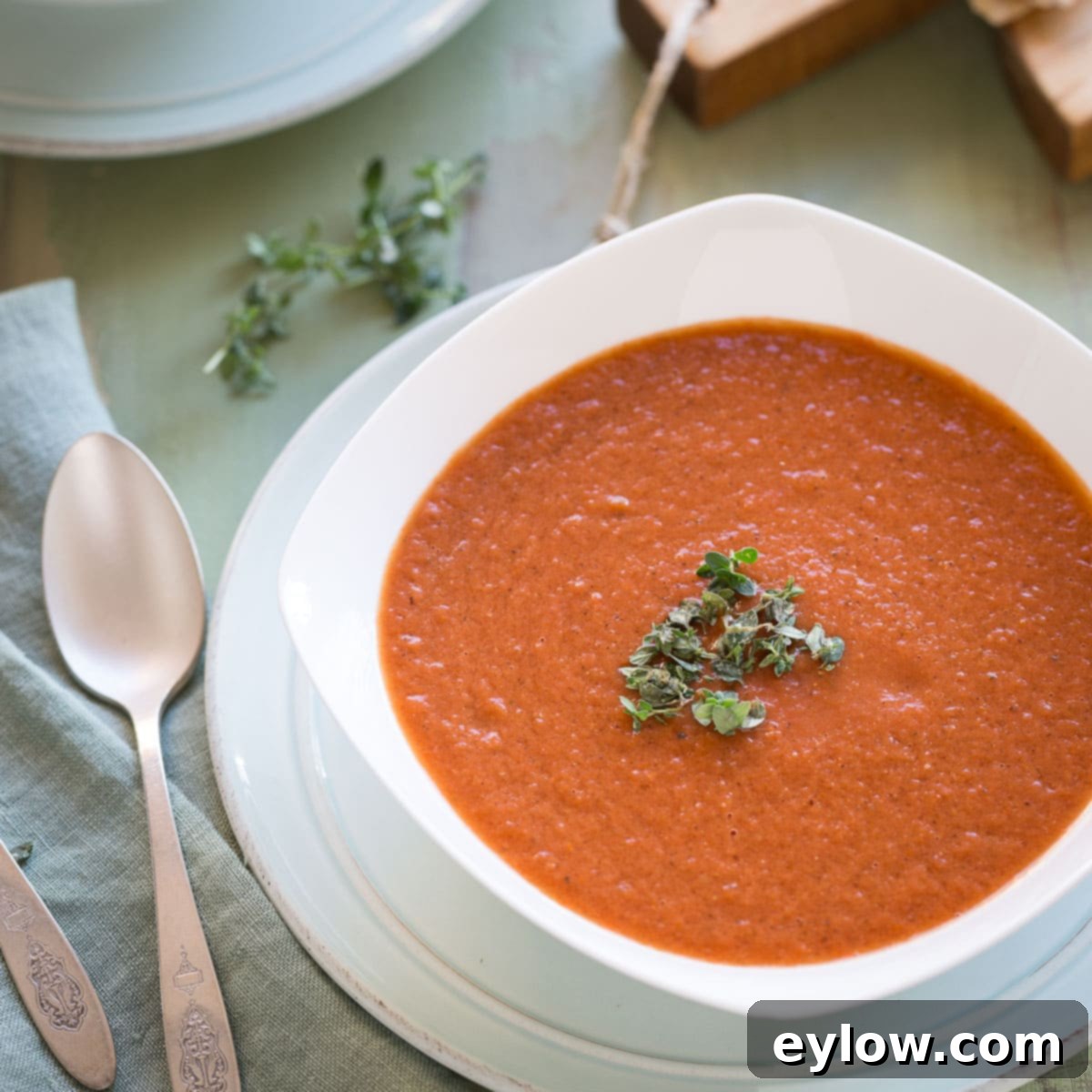
Recipe FAQs: Your Questions Answered
Absolutely! When making tomato soup using canned tomatoes, you have a lot of flexibility. Diced tomatoes are a great choice for a slightly chunkier texture, while crushed tomatoes will yield a smoother base with minimal effort. Whole tomatoes work perfectly too; you might just want to break them up with your hands or a spoon, and perhaps squeeze out some of the seeds if you prefer. For an added layer of flavor complexity, fire-roasted tomatoes introduce a delicious smoky note that complements the tanginess of the tomatoes beautifully. Beyond traditional cans, you can also use tomatoes packaged in jars or cartons, which are often preferred for their slightly fresher taste and BPA-free packaging. All these options will yield a delicious soup.
Adding cream is entirely a matter of personal preference and how you envision your ideal tomato soup. If you desire a rich, velvety “cream of tomato” soup, then yes, adding a touch of heavy cream, half and half, or even evaporated milk after the soup has been blended smooth will transform its texture and flavor. Stir it in gently over low heat, ensuring it doesn’t boil. For those seeking a dairy-free creamy option, full-fat canned coconut milk is a fantastic substitute; it imparts a wonderful richness and a subtle, pleasant sweetness that turns the soup into a luscious tomato bisque. You can also skip it altogether for a lighter, equally delicious and vibrant tomato soup.
Garnishes are a wonderful way to elevate simple tomato soup, adding visual appeal, texture, and additional layers of flavor. To dress up your bowl, consider topping it with crispy garlic croutons for a satisfying crunch, or a sprinkle of fresh chopped Italian parsley or vibrant basil leaves for an herbaceous burst. A delicate squiggle of balsamic syrup (or balsamic glaze) adds a sophisticated sweet-tart note. For a cheesy touch, a dusting of freshly grated Parmesan cheese is always a winner. Alternatively, a dollop of sour cream or Greek yogurt can provide a refreshing, tangy counterpoint, balancing the richness of the soup. Don’t hesitate to experiment with a combination of these for a truly gourmet experience!
Explore More Delicious Soup Recipes
The world of soup is incredibly diverse and deeply satisfying, offering a vast array of flavors, textures, and ingredients. From the simple, smooth, and creamy purees to hearty, robust stews filled with meats and a medley of vegetables, there’s a soup for every occasion and every palate. This homemade tomato soup is just the beginning of your culinary journey into the comforting realm of soups. Be sure to explore our comprehensive soup recipes index page for many more delicious options, whether you’re craving something light, filling, quick, or perfect for a special gathering.
- Beef Barley Vegetable Soup
- Instant Pot Navy Bean Soup Recipe (with ham)
- Italian Ribollita Soup Recipe
- Roasted Red Pepper Soup (sheet pan recipe)
Original post 11/16/2009
📖 Recipe
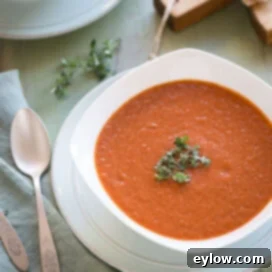
Tomato Soup From Canned Tomatoes
Sally Cameron
Pin Recipe
Equipment
-
Blender or stick blender to puree soup
-
Medium pot or pan
Ingredients
Soup
- 1 tablespoon extra virgin olive oil divided use
- 1 medium onion, finely chopped 1 ¼ cups
- 3-4 large garlic cloves, finely chopped
- 2-3 cups broth of choice chicken, turkey or vegetable
- 2 28-ounce cans diced tomatoes
- 1 teaspoon dried thyme or oregano leaves
- 2 teaspoons ground cumin optional
- 2 teaspoons smoked paprika optional
- ¼ teaspoon sea salt
- ¼ teaspoon ground black pepper
Optional Garnishes
- fresh chopped chives or scallions
- fresh chopped cilantro, parsley or basil
- Dollops of pesto
Instructions
-
In a large pot (4-5 quarts), heat the oil over medium-low heat. Add the onion and cook, stirring occasionally, until soft but not browned, about 4 minutes. Next add the dried herbs and spices and cook stirring 1-2 minutes. Add the garlic and cook another 1 minute.
-
Add the broth and tomatoes with their juices. Bring to a simmer over medium-high heat. Reduce the heat to low, cover, and simmer for 20-25 minutes to blend the flavors. Let the soup cool briefly and then purée in batches in a blender.
-
Rinse the pot and return the soup to the pot to heat if needed. Serve warm, garnished as desired.
